

Minecraft for Archaeological Outreach. The “Real Tools of Minecraft” We ran a “Virtual Dig” event for Yornight again this year, refined and improved from last year’s effort.
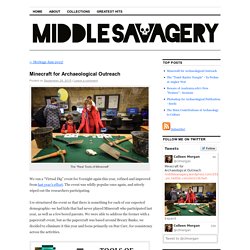
The event was wildly popular once again, and utterly wiped out the researchers participating. I re-structured the event so that there is something for each of our expected demographic–we had kids that had never played Minecraft who participated last year, as well as a few bored parents. We were able to address the former with a papercraft event, but as the papercraft was based around Breary Banks, we decided to eliminate it this year and focus primarily on Star Carr, for consistency across the activities. Steal me! For the younger kids we expanded on our “real tools of Minecraft” event last year. I’ve uploaded a printable pdf of the Minecraft tools. We also had our usual server running with the Star Carr landscape installed, which I wrote about making last year. Once again we also showed Anthony Masinton’s Yorkshire 9000BC on the big screen in back.
Archaeologyeducationclearinghouse.wordpress. Browsing Archaeological Atlas of Ohio by Title. Not All Are Buried Here: Selective Burial in Prehistoric Spain. Interpreting cemeteries in order to understand the living population is a dangerous and difficult task.
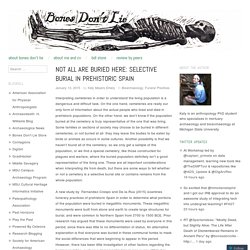
On the one hand, cemeteries are really our only form of information about the actual people who lived and died in prehistoric populations. On the other hand, we don’t know if the population buried at the cemetery is truly representative of the one that was living. Some families or sections of society may choose to be buried in different cemeteries, or not buried at all- they may leave the bodies to be eaten by birds or animals as occurs in some cultures. Another possibility is that we haven’t found all of the cemetery, so we only get a sample of the population, or we find a special cemetery, like those constructed for plagues and warfare, where the buried population definitely isn’t a good representation of the living one. Dolmen de Cabaleiros, via Flickr user Javier Pais. Tennessee Council for Professional Archaeology.
Ceramic vessel from Chalcolithic period Iran, 5000 – 3500 B.C.E.
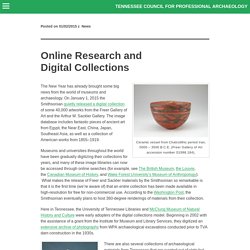
(Freer Gallery of Art accession number S1998.184). The New Year has already brought some big news from the world of museums and archaeology. Ohio - Eastern Woodlands Household Archaeology Data Project. Genome Sequencing Highlights the Dynamic Early History of Dogs. Gringo Trails: Is tourism destroying the world? Documentary explores fallout from mismanaged tourism in developing worldFilmmaker uses dramatic examples from around worldFilms looks at "dark tourism," travel to sites associated with suffering and danger.

Interactive Dig - Archaeology Magazine's Online Excavations (Past Digs) Colonial Cemeteries. John Whittaker, Anthropology, Grinnell College> The Rosenstock Pot and the Development of Agriculture in Maryland. This week’s blog post features a spectacular pre-Columbian pottery vessel known at the Maryland Archaeological Conservation Lab as the Rosenstock Pot.
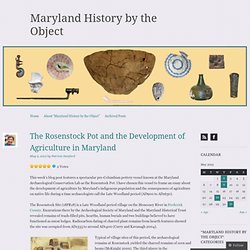
I have chosen this vessel to frame an essay about the development of agriculture by Maryland’s indigenous population and the consequences of agriculture on native life during a time archaeologists call the Late Woodland period (AD900 to AD1650). The Rosenstock Site (18FR18) is a Late Woodland period village on the Monocacy River in Frederick County. : Louisiana Archaeology Society : William F.
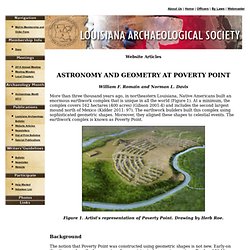
Romain and Norman L. Davis More than three thousand years ago, in northeastern Louisiana, Native Americans built an enormous earthwork complex that is unique in all the world (Figure 1). At a minimum, the complex covers 162 hectares (400 acres) (Gibson 2001:4) and includes the second largest mound north of Mexico (Kidder 2011: 97). Www.crt.state.la.us/archaeology/ppwhi/Monumental Earthworks of Poverty Point.pdf. Arkansas Novaculite: A Virtual Comparative Collection. What is this Website?

This website is a virtual lithic comparative collection featuring Arkansas Novaculite from Ouachita Mountain sources. It is aimed at archeologists and other researchers who work in Arkansas and in surrounding states and who need comparative materials to help them identify and source stone artifacts from archeological sites. This website serves as an educational website for anyone interested in the history and archeology of Arkansas and the American midcontinent. The website describes and illustrates the variation within and between sources of this important toolstone. Information on the effects of heat treatment of novaculite is included, as well as results of chemical characterization studies of samples from specific novaculite quarries. Novaculite was an important raw material used by Indians who lived in this region for thousands of years. Maney Publishing - Journal of Community Archaeology & Heritage. The Archaeological Journal: Volumes.
Access to all ADS resources is free, but you must accept the ADS Terms and Conditions of Use before using ADS Archsearch or Archive services.
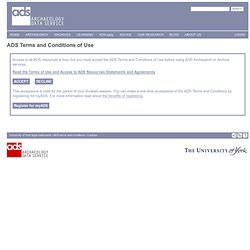
Read the Terms of Use and Access to ADS Resources Statements and Agreements. Mesoweb. Strats_keys. Stratigraphy Questions. Poster Stratigraphy. Artifacts Questions. Archeological resources for educators. The study of archeology has great potential for motivating young people, instructing them in a wide variety of skills, and inspiring in them an appreciation for the importance of preserving our nonrenewable cultural heritage.
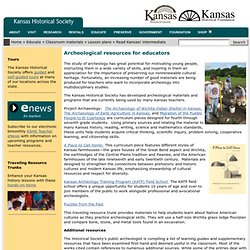
Fortunately, an increasing number of good materials are being produced for teachers who want to incorporate archeology into multidisciplinary studies. The Kansas Historical Society has developed archeological materials and programs that are currently being used by many Kansas teachers. Sample Archaeology for Kids.
The Mesoamerican Ballgame - Activity 3T. Kids and Teens: School Time: Social Studies: Archaeology. Of Stone Circles, Chambered Tombs, Prehistoric Rock Art, Cursus Monuments, Holy Wells. Lesson Plans: Simulated Digs. SciGirls: Digging Archaeology . Video.